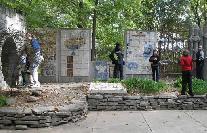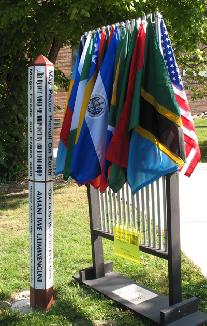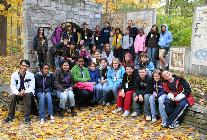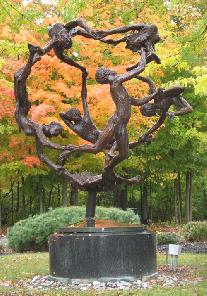AMERICAS
The Lion and Lamb Peace Arts Center (USA)
(May 24, 2010)
by Louise Matthews, Director
The Lion and Lamb Peace Arts Center was founded in 1987 as a resource and program center in collaboration with Bluffton University by Dr. Elizabeth "Libby" Hostetler to provide an environment for children and students to consider themes of peace and justice, cultural understanding and nonviolent responses to conflict.
The center includes a wide collection of children's and juvenile literature, art and sculptures, DVDs and CDs, all focusing on themes of peace and cultural appreciation. The center also owns teacher resources and curriculum guides. These resources can be accessed through the campus library catalog or our online bibliographies on our home page.
The original illustrations from the children's book, Sadako and the Thousand Paper Cranes, written by Eleanor Coerr and illustrated by Ronald Himler, are on display in the center. This collection of art and the true story of Sadako's life and death are reminders of the need for peace and cultural understanding.
In front of the center, there is the Peace Garden where visitors can see some sculptures, including "Peace Wall and Moon Gate" created by Jon Barlow Hudson. The wall replicates the Berlin Wall, prison bars, a stockade wall and memorial wall as an interactive art experience representing how we close people out, hold them in or immortalize them with walls of various kinds. On the stockade, prison and memorial wall sections are the names of those who have spent their lives working for peace and justice. Some have died as a result, some have been imprisoned but all, regardless of the sacrifice, have been committed to working for peace and justice around the globe. The circular shape of the moon gate represents unity and completeness entering our lives. Passing through the moon gate is a symbolic gesture of refusing to allow walls to separate us from others.
Interactive presentations are customized to fit each program audience regardless of age, incorporating children's literature, music, art, drama, object lessons and other appropriate means to address topics including, but not limited to the following: kindness and respect, appreciating diversity, cultural understanding, immigration, resolving conflicts, peacemaking and more.
Regardless of the age of the audience, a picture book is chosen to introduce a topic of peace or cultural understanding. We have found that the message in picture books is relevant for all of us, even college students and adults. The story is reinforced through discussion, art, music, drama and any other interactive activities and objects to reinforce the lessons. For example, the book “Hey Little Ant” written by Phillip and Hannah Hoose, can begin a conversation on bullying, the use and abuse of power, making choices, interdependence, and situations from history when decisions were made based on unequal power.
Visit our website www.bluffton.edu/lionlamb/ to access our resources and bibliographies, including the "Director's Choice" of recommended literature at www.bluffton.edu/lionlamb/director/ and to take a virtual "art tour across campus" from the "Art" page. Please contact us with questions or to explore collaborative efforts.
Address: 1 University Drive, Bluffton, Ohio USA 45817
Phone: +1-419-358-3207
Homepage: www.bluffton.edu/lionlamb/
Days open: Tuesday/Wednesday/Thursday 9am-5:00pm; Friday mornings 9am-noon; Additional times by appointment
Admission: Free
(Originally published on May 17, 2010)
 Peace Museums of the AMERICAS
Peace Museums of the AMERICAS



